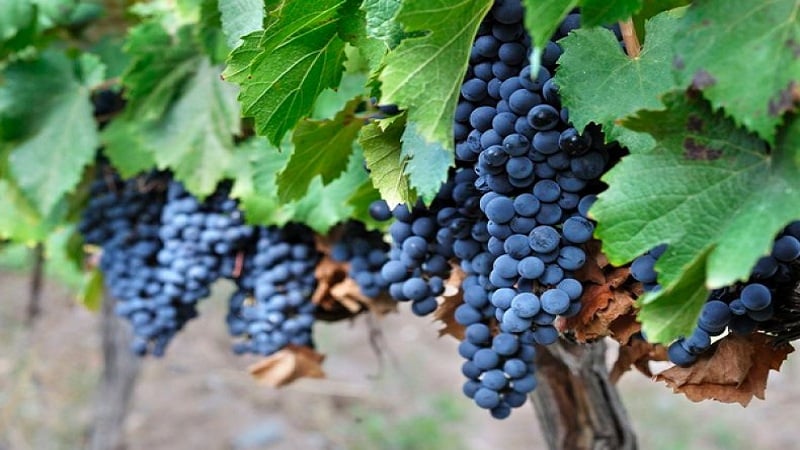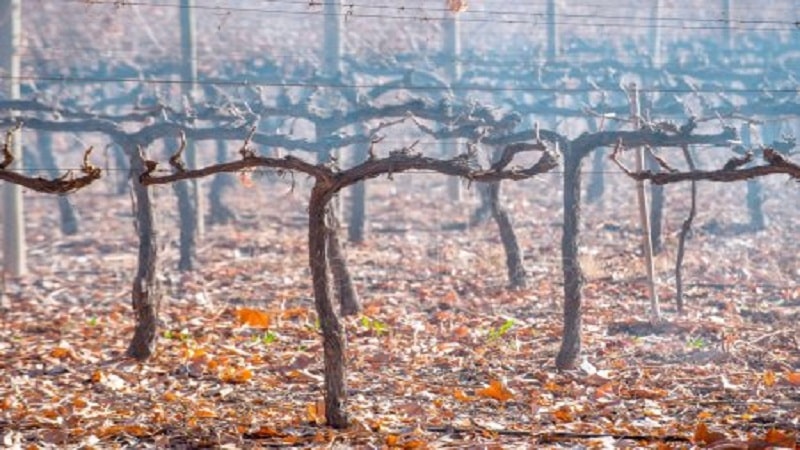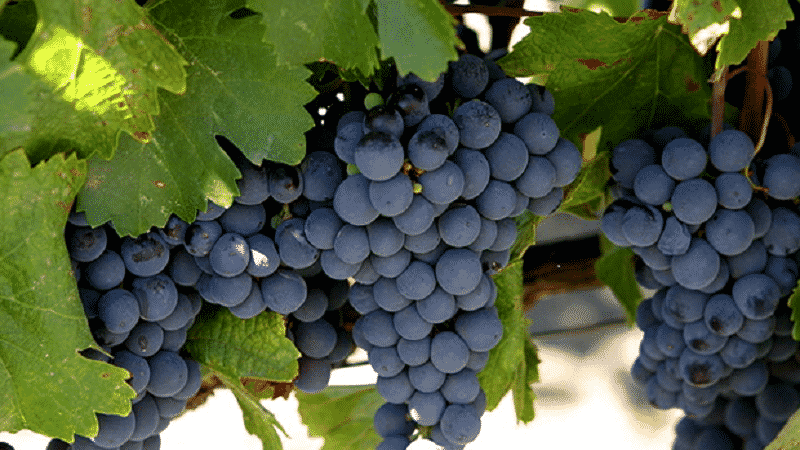The famous wine grape variety Malbec
Malbec is a technical dark grape variety originally from France with its own unique character. The crop received its “second wind” in Argentina, where it confidently took the position of the flagship variety. It was in this country that the grapes reached their best potential thanks to the suitable climate and rocky soil.
History and description of the Malbec grape variety
The Malbec grape is known in many countries. According to legend, the vine came to France thanks to the Hungarian farmer Malbec, who began growing it. At first, grapes were used to even out the taste of wines from other varieties.
Over time, the culture took root in France, and now occupies the bulk of the plantings in the Cahors district, and in Bordeaux it is one of the 6 permitted varieties. Here the variety is grown under the name Cot.
Reference. The Malbec variety has other names. In France, in addition to Cot, it is called Pressac, Quercy, Auxerrois. The common word Pied Noir means “black leg.”
According to another version, the authorship belongs to French breeders. Malbec was obtained by crossing late and medium ripening varieties. The plant is part of the Western European group and is cultivated in France, Argentina, Chile, USA, and northern Italy.
Malbec has had its ups and downs. In 1956, frost destroyed about 75% of the bushes in Europe, so winegrowers switched to hardier and frost-resistant varieties.
In the mid-19th century, the culture came to Argentina thanks to Michel Pouget.It was in this country that she embarked on a new path of development. Here the berries ripen better and acquire maximum aroma, color and juiciness. The area of grape plantations in Argentina occupies more than 28 thousand hectares. In the province of Mendoza, 80% of all plantations are cultivated. There are 22 clones of the variety officially registered in the country.
In the 80s of the twentieth century, Argentine winemakers refused to cultivate Malbec because of its low prospects and began the deliberate destruction of vineyards. Miraculously, about 10 thousand acres survived. A few years later, the Argentines realized their mistake and began to restore what they had lost. Wines from this variety have become so popular that they had to quickly plant young bushes, which have less potential compared to old vines.
Features of the Malbec variety:
- The bushes are low, characterized by insignificant growth force. The culture prefers shade and grows best in highlands with significant differences in night and day temperatures.
- The leaves are medium-sized, slightly funnel-shaped or flat with downward curved edges. The dissection varies: the leaf is whole or with deep cuts, three- and five-lobed. The surface is wrinkled, reticulate, with a faint cobweb edge.
- The petiole notch is open, lyre-shaped or vaulted.
- The flowers are bisexual and do not require additional pollination.
- The clusters are medium or small, conical or wide-conical, loose.
- The berries are medium-sized, round in shape, dark blue or black in color with a thick waxy coating. Length - 1.6 cm, weight - 4–6 g.
- The skin thickness is medium. The pulp is juicy and melts in your mouth. Recoil juice - 90%. The color becomes almost inky.
- The ripening period is 141–155 days from the moment of bud break to full ripeness at the sum of active seasonal temperatures of 2800–3050°C.
- The shoots ripen completely and grow 10–12 cm long.
- Productivity is unstable due to the tendency for flowers to fall off - 40–160 c/ha.
- Low resistance to mildew, anthracnose and gray rot, average resistance to oidium.
- Malbec is not resistant to winter frosts and late spring frosts.
The photo shows the Malbec grape variety.

Advantages and disadvantages
Advantages of the variety:
- suitable for producing wine with a rich fruit and berry taste and aroma;
- drought resistance;
- does not require additional pollination;
- high juice yield of berries;
- Possibility of growing on rocky soil.
Flaws:
- the tendency to shed flowers requires constant care for plantings;
- low resistance to fungal diseases and frost;
- unstable yield.
Malbec wine
The secret to the success of the Malbec grape lies in reflecting the character of each growing region. The technical variety with richly colored berries is suitable for the production of wines with a concentrated taste and a poor aroma. The bouquet reveals spicy, chocolate, marmalade, cherry, plum, oak and vanilla notes. The wines are characterized by high aging potential.
The harvest, collected in Argentina's Uco Valley, has excellent acidity and contains enveloping tannins. The color of the drink is deep, balanced and rich.
In the southern regions of Mendoza, Malbec ripens early and is characterized by increased sugar content and low acidity.
Reference. In Argentina, there are several wine-growing zones that control wines by origin (DOC).One such region is Lujan de Cuyo. Here the vineyards are located on rocky soil, and the color of the wine is almost black.
A drink made from Malbec grapes, prepared without aging in barrels, is recommended to be consumed within a year. Wine aged for 3-4 months is stored in bottles for 2-3 years, with a long aging period (up to a year) - up to 10 years.
Malbec wines fall into the mid-price category, making them an alternative to more expensive drinks. Interestingly, the aroma changes depending on the climate. When grown in cooler France, the wine is produced with raspberry and cherry notes. Argentine wine smells of plum and blackberry. The longer the aging, the stronger the notes of tobacco, coconut and vanilla are felt in the aftertaste.
Malbec is served with red meat, hard cheeses, pasta with thick tomato sauce. The temperature of the drink is +17…+21°С.
Planting seedlings
The variety shows better productivity when the vineyards are located on hills on the southern side of the site with protection from gusty winds. The bushes do not tolerate drafts and react by reducing the rate of development and taste of the berries. A suitable type of soil is black soil or rocky soil with a lot of sand.
Landing is carried out cuttings. 24 hours before, they are soaked in a growth stimulant (“Epine”). Pits measuring 70x70 cm are formed on the site. Drainage (crushed stone or broken brick) is placed at the bottom. The earth is mixed with mullein solution (1:10). A layer of clean soil is poured on top, then a cutting with a developed root system is planted and covered with soil to the level of the root collar. The soil is compacted and watered abundantly.
Planting is carried out in the second ten days of April - mid-May, since the plant does not tolerate return frosts. The exact timing depends on the climate in the region.
Subtleties of further care

The vineyard needs moderate watering. The best way is to install a drip system and sprinkling during periods of prolonged drought.
Fertilizing is applied three times per season, taking into account the growing season:
- at the beginning of leaf formation, the bushes are fertilized with nitrogen-containing agents (20 g of superphosphate and 15 g of potassium salt per 10 liters of prepared chicken manure solution);
- during the formation of ovaries - phosphorus (60 g of superphosphate and 30 g of potassium sulfate per 10 liters of water);
- during fruiting - potassium (100 g of superphosphate and 50 g of potassium sulfate per 10 liters of water).
Trimming
The shoots ripen quickly, so pruning carried out three times a year: in the spring, dead and weakened branches are removed, in the summer they are shortened after the first ovaries appear, in the fall - after harvesting.
Winegrowers recommend using a short pruning technique, popularly called “on the knot.” After this procedure, 2–4 eyes remain on the shoots. Layers from the first eye are broken off by hand so that the vine grows inside the bush and not out.
Wintering
In late autumn, they begin to prepare the vines for winter: they water the soil abundantly and shelter made of spruce branches, slate, straw, agrofibre or thick film. Leave a vent for air circulation and close it when the air temperature drops below -18°C.
Disease and pest control
Low resistance to mildew and oidium requires preventive processing plantings with Ridomil, Bordeaux mixture, preparations with colloidal sulfur.
The grapes are not resistant to the pathogens of anthracnose (signs - dark spots on leaves and berries) and gray rot (gray-brown coating on shoots and berries). For the treatment of anthracnose, “Acrobat” and “Anthracol” are used, gray rot - “Thanos”, “Horus”, “Strobe”, “Bayleton”, “Topsin-M”, “Rubigan”.
Advice. To protect the crop from attacks by wasps, each bunch is placed in a fine mesh or fabric bag.
Cluster moth caterpillars pose a danger to the crop. Pests feed on flowers and berries, destroying up to 40% of the crop. Gray rot develops on damaged berries.
To kill insects, insecticides (Zolon, Fury, Talstar, Enzhio 247) and biological products (Fitoverm, Lepidotsid, Actofit, Bitoxibacillin) are used.
Harvest and storage

It is undesirable to leave the Malbec harvest on the bush due to the tendency for the berries to fall and crack. It is harvested in late autumn and immediately sent for processing, since technical grade grapes cannot be stored for long periods of time.
Similar varieties
There are several varieties that have similar characteristics to the Malbec grape:
- Shiraz or Syrah - red variety. The main part of the vineyards is located in France. The crop is grown in Australia, USA, South Africa. The plant requires a lot of sunlight and heat to mature. When overripe, the characteristics of the variety are lost. The berries are dense, juicy, with a thick, almost black skin. The result is a wine with a high alcohol content, dense, with the aroma of fruits, spices, chocolate and black pepper.
- Merlot - The world's second most common variety of red wine grapes, originally from Bordeaux. The berries are large with thin dark blue skin.The wines contain few tannins, more sugar and less malic acid. The young drink captures the aroma of raspberries, blackberries, cherries, violets, plums, coffee and cocoa. When ripe, notes of fig, chocolate, black pepper, truffle and leather appear.
- Dolcetto - Italian wine variety grown in Piedmont. The berries are small, dark blue, juicy. Translated from Italian, it literally means “small sweet,” although the name does not reflect the essence of the finished drink. The wine is tart, dry, with low acidity, notes of licorice and almond and a slight bitter aftertaste.
- Toriga Nacional - a newfangled technical dark grape variety that is gaining popularity in Portugal. The thick peel with an intense tint is responsible for the color of the finished drink. The variety is used for making fortified wines. Grapes give the wine a viscous consistency and the ability to age.
- Petit Verdot - a technical grape variety with small dark blue berries. Forms more than 2 clusters on one shoot. Wine from Petit Verdot acquires a blue-black hue and a high level of tannins. The variety is cultivated in Italy, Portugal, Spain, Chile, and Argentina.
- Nero d'Avola - the most common black grape on the island. Sicily. The name translates as “black from Avola,” a city in southeastern Sicily. Wines from this variety are distinguished by their high tannin content, peppery and plum notes.
- Mourvedre - a technical variety of red grapes native to Spain. The berries are small, thick-skinned, dark, with a record high tannin content. The wine has a thick texture, rich color and a blackberry-cherry bouquet.
Conclusion
The dark wine grape variety Malbec originated in France, but is most widespread in sunny Argentina. The local climate turned out to be more favorable for cultivating the crop. Berries with juicy pulp and dark blue, almost black skin are used to produce rich wine with a fruity aroma and hints of spice.
The crop is characterized by low resistance to fungi and frost, unstable yield due to the tendency to shed flowers. To maintain health, plants are treated with fungicides and covered for the winter.